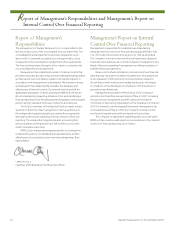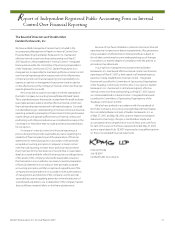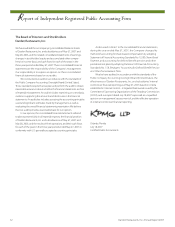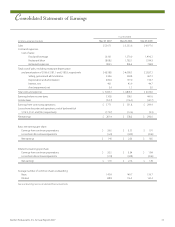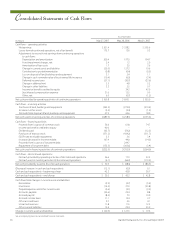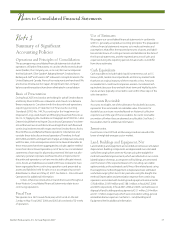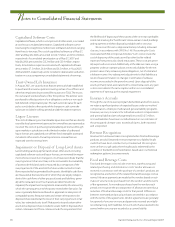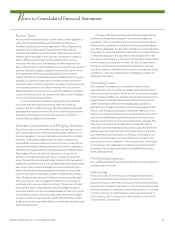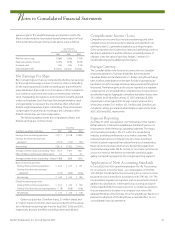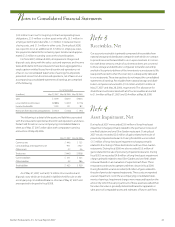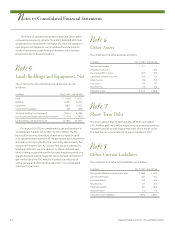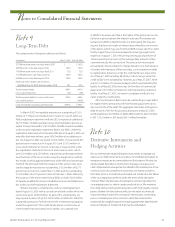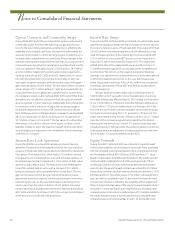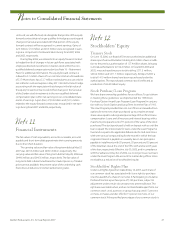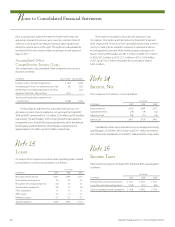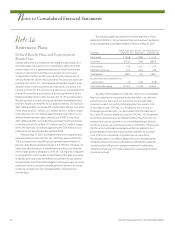Red Lobster 2007 Annual Report Download - page 42
Download and view the complete annual report
Please find page 42 of the 2007 Red Lobster annual report below. You can navigate through the pages in the report by either clicking on the pages listed below, or by using the keyword search tool below to find specific information within the annual report.
40 Darden Restaurants, Inc. Annual Report 2007
Notes to Consolidated Financial Statements
N
Stock-Based Compensation
Effective May 29, 2006, we adopted the provisions of SFAS No. 123(R),
“Share-Based Payment,” which requires companies to recognize in
the financial statements the cost of employee services received in
exchange for awards of equity instruments based on the grant date
fair value of those awards. Previously, SFAS No. 123, “Accounting for
Stock-Based Compensation,” encouraged, but did not require, that
stock-based compensation be recognized as an expense in compa-
nies’ financial statements. Accordingly, we elected to account for our
stock-based compensation plans under an intrinsic value method
that required compensation expense to be recorded only if, on the
date of grant, the current market price of our common stock
exceeded the exercise price the employee must pay for the stock.
Our practice is to grant stock options at the fair market value of our
underlying stock on the date of grant. Accordingly, prior to the
adoption of SFAS No. 123(R), no compensation expense had been
recognized for stock options granted under any of our stock plans
because the exercise price of all options granted was equal to the
current market value of our stock on the grant date. Due to the
adoption of SFAS No. 123(R), during fiscal 2007, we recognized
$17.1 million ($10.6 million net of tax) in stock-based compensation
expense related to stock options and benefits granted under our
Employee Stock Purchase Plan, discussed below, which reduced our
basic and diluted net earnings per share from continuing operations
by $0.07 and $0.08, respectively.
Prior to the adoption of SFAS No. 123(R), benefits of tax deduc-
tions in excess of recognized stock-based compensation expense
were reported as operating cash flows. Under SFAS No. 123(R), such
excess tax benefits are reported as financing cash flows. Although
total cash flows are not impacted and remain unchanged from what
would have been reported under prior accounting standards, due to
the adoption of SFAS No. 123(R) net cash flows provided by oper-
ating activities were reduced by $40.0 million and net financing cash
flows were increased by $40.0 million during fiscal 2007, due to the
classification of these tax benefits as a financing activity as opposed
to an operating activity.
We adopted SFAS No. 123(R) according to the modified
prospective transition method and use the Black-Scholes option
pricing model to estimate the fair value of awards. Under the modified
prospective transition method, we recognize compensation expense
on a straight-line basis over the remaining employee service period for
new awards granted after the effective date of SFAS No. 123(R) and for
unvested awards granted prior to the effective date of SFAS No. 123(R).
In accordance with the modified prospective transition method,
financial statements issued for periods prior to the adoption of
SFAS No. 123(R) have not been restated.
Had we determined compensation expense for our stock
options and benefits granted under our Employee Stock Purchase
Plan for fiscal 2006 and 2005 based on the fair value at the grant date
as prescribed under SFAS No. 123, our earnings from continuing
operations and net earnings from continuing operations per share,
excluding pro-forma stock-based compensation expense from
discontinued operations, would have been reduced to the pro
forma amounts indicated below:
Fiscal Year
(in millions, except per share data) 2006 2005
Earnings from continuing operations $351.8 $299.9
Add: Stock-based compensation
expense included in reported net earnings,
net of related tax effects 5.1 4.9
Deduct: Total stock-based compensation
expense determined under fair value
based method for all awards, net of related
tax effects (18.4) (21.3)
Pro forma $338.5 $283.5
Basic net earnings per share from
continuing operations
As reported $ 2.35 $ 1.91
Pro forma $ 2.26 $ 1.81
Diluted net earnings per share from
continuing operations
As reported $ 2.24 $ 1.84
Pro forma $ 2.16 $ 1.73
To determine pro forma net earnings, reported net earnings
have been adjusted for compensation expense associated with
stock options granted that are expected to vest and benefits granted
under our Employee Stock Purchase Plan. Total stock-based
compensation expense also includes costs related to restricted stock
and other forms of stock-based compensation granted to our
employees that have always been required to be recognized in our
financial statements. See Note 17 – Stock-Based Compensation for
further discussion. The preceding pro forma results were determined
using the Black-Scholes option-pricing model. The weighted-
average fair value of non-qualified stock options granted during
fiscal 2007, 2006 and 2005 used in computing compensation
expense in fiscal 2007 and pro-forma compensation expense in
fiscal 2006 and 2005 was $13.87, $10.68 and $7.75, respectively. The
dividend yield was calculated by dividing the current annualized
dividend by the option exercise price. The expected volatility was
determined using historical stock prices. The risk-free interest rate
was the rate available on zero coupon U.S. government obligations
with a term approximating the expected life of each grant. The
expected life was estimated based on the exercise history of


